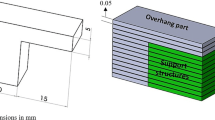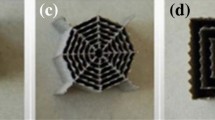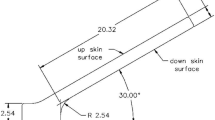Abstract
The current study aims to design optimal support structures for the fabrication of titanium alloy overhangs by electron beam melting such that they are easy to remove and consume less material without affecting the part quality. To achieve this objective, the effect of design and process parameters of the perforated block support structures was evaluated and optimized using response surface methodology and multi-objective genetic algorithm. The results showed that it is possible to reduce the support volume by 19% and support removal time by 45% without any warping deformation using the optimum combinations (tooth height of 2.885 mm, tooth base interval of 1.677 mm, perforation beam of 4.611 mm, beam current of 5.327 mA, and beam scan speed 1347.197 mm/s). In addition the multi-objective optimization results found the optimal perforated supports characterized by 4-mm tooth height, 2-mm tooth base interval, 2-mm perforated beam, 6-mA beam current, and 1600 mm/s beam scan speed. The study also showed that the use of optimum support structures results in substantial reduction of the support volume and post-processing.






















Similar content being viewed by others
References
Wong H, Neary D, Jones E, Fox P, Sutcliffe C (2019) Pilot capability evaluation of a feedback electronic imaging system prototype for in-process monitoring in electron beam additive manufacturing. Int J Adv Manuf Technol 100:707–720. https://doi.org/10.1007/s00170-018-2702-6
Terrazas CA, Mireles J, Gaytan SM, Morton PA, Hinojos A, Frigola P, Wicker RB (2016) Fabrication and characterization of high-purity niobium using electron beam melting additive manufacturing technology. Int J Adv Manuf Technol 84:1115–1126. https://doi.org/10.1007/s00170-015-7767-x
Biffi CA, Fiocchi J, Ferrario E, Fornaci A, Riccio M, Romeo M, Tuissi A (2020) Effects of the scanning strategy on the microstructure and mechanical properties of a TiAl6V4 alloy produced by electron beam additive manufacturing. Int J Adv Manuf Technol 107:4913–4924. https://doi.org/10.1007/s00170-020-05358-y
Tarasov SYu, Filippov AV, Savchenko NL, Fortuna SV, Rubtsov VE, Kolubaev EA, Psakhie SG (2018) Effect of heat input on phase content, crystalline lattice parameter, and residual strain in wire-feed electron beam additive manufactured 304 stainless steel. Int J Adv Manuf Technol 99:2353–2363. https://doi.org/10.1007/s00170-018-2643-0
Utyaganova VR, Filippov AV, Shamarin NN, Vorontsov AV, Savchenko NL, Fortuna SV, Gurianov DA, Chumaevskii AV, Rubtsov VE, Tarasov SYu (2020) Controlling the porosity using exponential decay heat input regimes during electron beam wire-feed additive manufacturing of Al-Mg alloy. Int J Adv Manuf Technol 108:2823–2838. https://doi.org/10.1007/s00170-020-05539-9
Murr L, Quinones S, Gaytan S, Lopez M, Rodela A, Martinez E et al (2009) Microstructure and mechanical behavior of Ti–6Al–4V produced by rapid-layer manufacturing, for biomedical applications. J Mech Behav Biomed Mater 2:20–32
Liska WD, MARCELLIN‐LITTLE DJ, Eskelinen EV, Sidebotham CG, Harrysson OL, HIELM‐BJÖRKMAN AK (2007) Custom total knee replacement in a dog with femoral condylar bone loss. Vet Surg 36:293–301
Biamino S, Kloden B, Weibgarber T, Kieback B, Ackelid U (2014) Titanium aluminides for automotive applications processed by electron beam melting
Murr LE, Gaytan S, Ceylan A, Martinez E, Martinez J, Hernandez D et al (2010) Characterization of titanium aluminide alloy components fabricated by additive manufacturing using electron beam melting. Acta Mater 58:1887–1894
Cheng B, Chou YK (2017) Overhang support structure design for electron beam additive manufacturing. ASME 2017 12th International Manufacturing Science and Engineering Conference collocated with the JSME/ASME 2017 6th International Conference on Materials and Processing: American Society of Mechanical Engineers pp. V002T01A18-VT01A18
Gibson I, Rosen DW, Stucker B (2010) Additive manufacturing technologies: Springer
Calignano F (2014) Design optimization of supports for overhanging structures in aluminum and titanium alloys by selective laser melting. Mater Des 64:203–213
Poyraz Ö, Yasa E, Akbulut G, Orhangül A, Pilatin S (2015) Investigation of support structures for direct metal laser sintering (DMLS) of IN625 parts. International Solid Freeform Fabrication Symposium. Austin, Texas, USA
Gan M, Wong C (2016) Practical support structures for selective laser melting. J Mater Process Technol 238:474–484
Hussein A, Yan C, Everson R, Hao L (2011) Preliminary investigation on cellular support structures using SLM process. Innovative Developments in Virtual and Physical Prototyping Taylor & Francis Group, London, pp 609–612
Zeng K (2015) Optimization of support structures for selective laser melting: University of Louisville
Järvinen J-P, Matilainen V, Li X, Piili H, Salminen A, Mäkelä I et al (2014) Characterization of effect of support structures in laser additive manufacturing of stainless steel. Phys Procedia 56:72–81
Ameen W, Al-Ahmari A, Mohammed MK (2019) Self-supporting overhang structures produced by additive manufacturing through electron beam melting. Int J Adv Manuf Technol. https://doi.org/10.1007/s00170-019-04007-3
Cloots M, Spierings A, Wegener K (2013) Assessing new support minimizing strategies for the additive manufacturing technology SLM. Proceedings of the Solid Freeform Fabrication Symposium, Austin, TX, USA pp. 12–3
Wang D, Yang Y, Zhang M, Lu J, Liu R, Xiao D (2013) Study on SLM fabrication of precision metal parts with overhanging structures. Assembly and Manufacturing (ISAM), 2013 IEEE International Symposium on: IEEE p. 222–5
Krol T, Zäh M, Seidel C (2012) Optimization of supports in metal-based additive manufacturing by means of finite element models
Cheng B, Chou K (2015) Deformation evaluation of part overhang configurations in electron beam additive manufacturing. ASME 2015 International Manufacturing Science and Engineering Conference: American Society of Mechanical Engineers p. V001T02A72-VT02A72
Stringer J, Xu X, Zheng P, Jiang J (2018) A benchmarking part for evaluating and comparing support structures of additive manufacturing in Proceedings of the 3rd International Conference on Progress in Additive Manufacturing pp. 196–201. https://doi.org/10.25341/D42G6H
Zhang K, Mao Z, Fu G, Zhang DZ, Liu C, Li Z (2018) A feasible method of support slimming based on the different thresholds of polar angles in selective laser melting. Mater Des 157:501–511
Sulaiman MR, Yusof F, Jamaludin MF (2020) Effect of support structure design on the part built using selective laser melting. Springer. Adv Mater Sci Eng p. 275–86
Vayre B, Vignat F, Villeneuve F (2012) Metallic additive manufacturing: state-of-the-art review and prospects. Mech Ind 13:89–96
Hussein A, Hao L, Yan C, Everson R, Young P (2013) Advanced lattice support structures for metal additive manufacturing. J Mater Process Technol 213:1019–1026
Liang X, Dong W, Hinnebusch S, Chen Q, Tran HT, Lemon J et al (2020) Inherent strain homogenization for fast residual deformation simulation of thin-walled lattice support structures built by laser powder bed fusion additive manufacturing. Addit Manuf 32:101091
Funding
The authors are grateful to the Raytheon Chair for Systems Engineering for funding.
Author information
Authors and Affiliations
Corresponding author
Ethics declarations
Ethics approval
Not applicable.
Consent to participate
Not applicable.
Consent for publication
Not applicable.
Conflict of interest
The authors declare no competing interests.
Additional information
Publisher's Note
Springer Nature remains neutral with regard to jurisdictional claims in published maps and institutional affiliations.
Rights and permissions
About this article
Cite this article
Ameen, W., Mohammed, M.K., Al-Ahmari, A. et al. Optimization of perforated support structures for electron beam additive manufacturing. Int J Adv Manuf Technol 120, 7305–7323 (2022). https://doi.org/10.1007/s00170-022-09195-z
Received:
Accepted:
Published:
Issue Date:
DOI: https://doi.org/10.1007/s00170-022-09195-z




